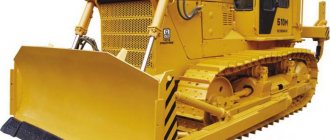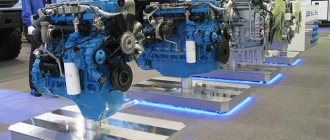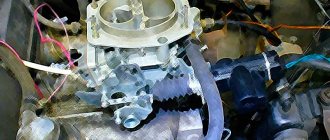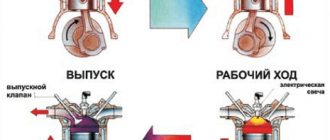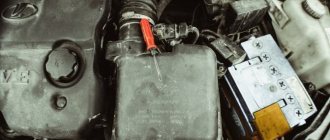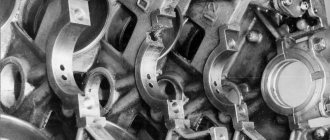- home
- /
- Articles
- /
- Diesel engine: design and operating features
Every year more and more drivers are choosing diesel cars. They have lower fuel consumption, are cheaper to operate and have a long service life. But those who encounter this type of engine for the first time may have a number of questions. So, how does a diesel engine work, what features does it have and are there any disadvantages?!
Design and operation of a diesel engine
A diesel engine is a piston internal combustion engine. The principle of its operation is based on the fact that the fuel ignites spontaneously due to the supply of compressed air. Its design is practically no different from a gasoline power unit. The only exception is that a diesel engine does not have an ignition system: the fuel mixture is ignited not by a spark, but by high pressure. It compresses the air, causing it to become very hot and ignite the fuel mixture.
For many decades, diesel engines have been installed in special equipment and trucks, as well as passenger cars. If earlier such an engine had a number of disadvantages, today there are special additives and devices that “warm up” the fuel mixture, thanks to which the car starts without problems even at -30.
There are currently several types of diesel fuel. This can be rapeseed oil, pure or refined oil, friction substances, etc.
Operating principle of a diesel engine
The operating principle of a diesel engine is based on compression ignition of fuel. It enters the combustion chamber, where it begins to mix with hot air. The operation of the engine itself depends on the amount of air and other features.
The fuel assemblies are supplied separately: first, air is supplied, which during compression is heated to 700-900 degrees. After this, fuel is supplied at high pressure up to 30 (MPa). All this mixes and ignites, thanks to which the engine starts.
During ignition of the fuel-air mass, increased noise and strong vibrations may occur. But they do not create much discomfort.
Factors influencing the development of the third phase
- The quality of atomization and the amount of fuel injected after the start of combustion. The less fuel is supplied before the start of the third phase of combustion, the less heat will be released in this phase, which is typical for diesel operation at low loads.
- The speed of the air charge. An increase in the speed of charge movement increases heat generation, but this occurs up to a certain point. If the charge swirls excessively, the heat release in the third phase decreases, since in this case the combustion products from the zone of one torch enter the zone of the other, increasing the incompleteness of combustion.
- Crankshaft speed As the crankshaft speed increases, the speed of the charge increases and the atomization improves. The duration of the third phase is reduced.
The fourth phase of combustion (04) - afterburning begins at the moment the maximum temperature is reached and continues throughout the entire time the fuel burns out. During this phase, the fuel that did not have time to burn in the third phase burns out, and this happens in conditions of lack of oxygen, since a significant amount of it has already been consumed. Therefore, afterburning proceeds slowly.
During the fourth phase, at full load, the diesel engine releases 15-25% of heat. Thus, the total amount of heat release by the end of the fourth phase remains 90-95%. The remaining 5-10% is lost due to incomplete combustion of fuel. The duration of the fourth phase is 3.5-5 ms. which corresponds to 50-60° crankshaft rotation.
Diesel engine operating procedure
A diesel internal combustion engine can have 2 or 4 power strokes:
- inlet or suction. At this stage, air enters the cylinder through the open intake valve;
- compression. Under the action of the piston, the air that enters the cylinder is compressed several times, and its temperature increases to 800-00 degrees;
- working stroke. The gases generated during combustion move the plunger down;
- release or working stroke. The crankshaft rotates 540-720 degrees from its original position, the cylinder moves down, and the exhaust gases move down.
Many modern cars and trucks are equipped with a four-stroke engine.
Type of diesel internal combustion engines
There are three main types of diesel engine:
- with a divided combustion chamber. In it, fuel is supplied to an additional chamber. Air enters the vortex chamber and is compressed, which improves the combustion process of the fuel;
- with an undivided combustion chamber. This engine is distinguished by its efficiency, but at the same time it has a high noise level, which can cause some discomfort for the driver and passengers;
- prechamber motor. Such an internal combustion engine is equipped with an inserted prechamber. It is connected to the cylinder using thin valves. It is the shape and size of the channels that determines the speed of movement of gases during the combustion of heavy fuel. This type of engine is distinguished by the fact that it has a low noise level and toxicity, which allows to increase its service life.
The last option is the most popular. While driving, it does not create unnecessary noise, so nothing distracts you.
Diesel engine operating system
The main component of any engine is its fuel system. Its main task is the timely supply of fuel. Moreover, it must have a certain pressure and temperature. If these two rules are not followed, the car simply will not start.
The main elements of a diesel engine are the following elements:
- fuel pump;
- filter;
- injectors.
Let's take a closer look at each of these elements.
Fuel pump
It is responsible for supplying fuel to the injectors. Modern engines are equipped with two types of fuel pumps: in-line and distribution.
Fuel filter
The filter is one of the most important elements of any engine. It cleans the fuel mixture of debris, various particles and excess air that may enter the system. The filter is selected according to the car model.
Injectors
Injectors also play an important role in the fuel system. They are responsible for the timely supply of fuel, so the performance and service life of the engine itself depend on their reliability.
Diesel internal combustion engines use 2 types of injectors:
- with distributor;
- with font distributor.
The nozzle distributor determines the intensity and shape of the torch and is responsible for the timeliness and intensity of the fire.
Necessary additions to the turbocharging system: valves, intercooler
It took engineers decades to create a truly efficient turbocharger. After all, it’s only in theory that everything looks smooth: by converting the energy of exhaust gases, you can “recover” the lost percentage of efficiency and significantly increase engine power (for example, from one hundred to one hundred and sixty horsepower). But for some reason this did not work out in practice.
In addition, when you pressed the accelerator sharply, you had to wait for the engine speed to increase. It happened only after a certain pause. The increase in exhaust gas pressure, the spin-up of the turbine and the injection of compressed air did not occur immediately, but gradually. This phenomenon, called “turbolag” (“turbo lag”), could not be tamed. And it was possible to cope with it by using two additional valves: one to bypass excess air into the compressor through a pipeline from the engine manifold. And the other valve is for exhaust gases. And in general, modern turbines with variable blade geometry, even in their shape, are already significantly different from the classical turbines of the second half of the twentieth century.
Bosch diesel turbocharger
Another problem that had to be addressed during the development of diesel turbine technology was excessive detonation. This detonation occurred due to a sharp increase in temperature in the working cavities of the cylinders when additional masses of compressed air were pumped into them, especially at the final stage of the stroke. The charge air intercooler (intercooler) is designed to solve this problem in the system.
An intercooler is nothing more than a radiator for cooling the charge air. In addition to reducing detonation, it also reduces the air temperature in order not to reduce its density. And this is inevitable during the heating process from compression, and from this the efficiency of the entire system drops significantly.
In addition, a modern engine turbocharging system cannot do without:
- control valve (wastegate). It serves to maintain optimal pressure in the system, and to release it, if necessary, into the exhaust pipe;
- bypass valve. Its purpose is to divert charge air back into the intake pipes up to the turbine, if it is necessary to reduce power and the throttle valve closes;
- and/or “blow-off-valve”. Which bleeds charge air into the atmosphere if the throttle is closed and there is no mass air flow sensor;
- exhaust manifold compatible with turbocharger;
- sealed pipes: air pipes for supplying air to the intake, and oil pipes for cooling and lubrication of the turbocharger.
Advantages and disadvantages of a diesel engine
Separately, I would like to consider the advantages of the diesel engine. These include the following points:
- low fuel consumption. Diesel engines consume approximately 30-40% less fuel than gasoline internal combustion engines;
- long service life. Diesel units are the most reliable engines in the world. Many of them easily overcome the mark of 700-800 thousand kilometers;
- excellent acceleration and excellent traction. Diesel engines are distinguished by high torque, which allows the car to confidently accelerate at any speed;
- low level of toxicity. There is a myth that diesel is highly toxic. But this was before, since modern fuel processing systems reduce the amount of harmful substances to a minimum;
- high efficiency. Diesel fuel burns with great efficiency.
But, despite the obvious advantages of diesel engines, it also has minor disadvantages. These include long warm-up periods in cold weather. Since the diesel unit has minimal fuel consumption and high efficiency, it needs more time to warm up.
Turbocharged engine: operating rules
In order for a diesel turbine to operate with maximum efficiency and not fail for as long as possible, you need to adhere to certain rules during the operation of the car:
- adhere to the oil change schedule, which will prevent clogging of the oil line with abrasives;
- use high-quality motor oil that meets the specifications in the engine data sheet;
- do not start immediately after turning on the engine - the engine must be warmed up;
- immediately after stopping movement, do not turn off the engine, allowing it to idle for at least 10 seconds.
Diesel engine repair at the Auto-Maxima car service station in the Southern Administrative District of Moscow
In general, diesel engines have more advantages than disadvantages. First of all, it is low fuel consumption and long service life. But, even despite their reliability, even diesel engines can fail. Most often this happens due to bad roads or improper operation.
If you suddenly have a breakdown and you need to repair your diesel engine, you can safely contact the Auto Maxima service center in the Southern Administrative District of Moscow. Our specialists will carry out all the necessary work promptly, and you will receive a working car and a guarantee for all types of work.
Glow plugs
To warm up the cylinder head and cylinder block before a cold start, diesel engines use glow plugs. Short and wide spark plugs are an integral part of the car's electrical system. When the power is turned on, the elements in the candles heat up very quickly.
The spark plugs are turned on by turning the steering column specifically or using a separate switch. In the latest models, the spark plugs turn off automatically as soon as the engine warms up and accelerates above idle speed.


